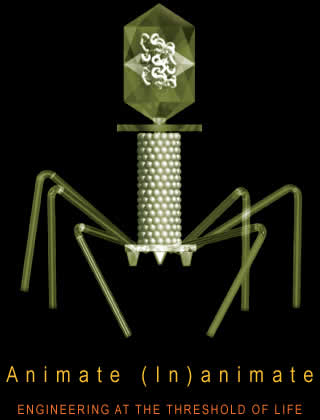
The Exploratorium presents Animate (in)Animate: Engineering at the Threshold of Life, a symposium exploring how new technologies are blurring the boundaries between the natural and the artificial.
We’ve long been used to making easy distinctions between the natural and the artificial, the organic and the inorganic, the biological and the manmade. However, new technologies are blurring these comfortable boundaries in unexpected ways. In addition to well-publicized breakthroughs in genomics and genetic engineering, a subtle and growing frontier of biotechnological innovation is creating new classes of artificially constructed “near-life” phenomena and “semi-living” technologies that occupy a gray area between inanimate matter and animate life. DNA based computing, the development of digital “organ printers” that print living tissue, and the use of genetically engineered viruses to assemble nanoscale electronic components are examples of recent technological innovations that suggest the emergence of a increasingly ‘technobiotic” world.
To provide a forum for exploring these innovations and attendant issues in depth, the Exploratorium is proud to present Animate (in)Animate, a daylong symposium bringing together an international panel of researchers, artists, and entrepreneurs. Animate (in)Animate will be held in the Cowell Theater at Fort Mason Center on Saturday, February 21, 2004.
The threshold of life : Discussion of the traits separating the animate and inanimate, such as replication, metabolic and evolutionary processes, genetics, and responsiveness to environmental stimuli.
Examples of “near-life” in the natural world : Examination of naturally-occurring mechanisms that satisfy some but not all of the traits of life, such as crystalline structures, organic molecules, viruses, antibodies, extra cellular DNA, proteins and enzymes.
Emerging technologies : “Near-life” technologies incorporate life-like subcellular organic elements into a variety of fields such as electronics manufacture and computer design, fuel cells, biocomposite materials, and nanoscale manufacturing processes. “Partial life” technologies involve the creation or use of living tissues in artificial environments for a variety of applications - medicine, food, biological research and art.
Visions and Values : What visions guide development of these technologies, and how should individuals and societies decide whether and how to employ them? How should cultural values be applied to our increasing control of biological processes? What are the longer-term implications of the creation of new kinds of “technobiotic” entities?
Brian Sager President, Nanosolar, Inc.
Oron Catts Artistic Director, SymbioticA
Evelyn Hu Co-Director, California Nanosystems Institute
Vladimir Mironov Researcher, Organ Printing, Department of Cell Biology & Anatomy, Medical University of South Carolina
Carlo Montemagno Co-Director, Institute for Cell Mimetic Space Exploration
Erik Winfree Researcher, Biomolecular Computing, Department of Computer Science, California Institute of Technology
Saturday,
February 21, 2004, from 10–4 p.m.
Cowell Theater,
Fort
Mason Center
Tickets
For
advance tickets, call: (415) 528-4308
Adults $12 /Students & Exploratorium Members $10
Tickets $14 onsite at the Cowell Theater on day of event
Concessions available onsite
Limited Scholarships available; Call (415) 674-2826 for more info
Please
be aware that the symposium content is designed for mature audiences.
Attendees under the age of 18 must be accompanied by an adult or provide
proof of parental consent to attend the symposium. Please be prepared
to show ID when you pick up your tickets.
Credits
Image: Computer rendering of a T4 phage virus by Roger Wagner, University of Delaware. Genetically modified phage viruses similar to this have been used experimentally to assemble nanoscale electronic components.
Animate
(in)Animate is presented in conjunction with the
Exploratorium’s
“Traits of Life” exhibition
, an exhibit collection funded
by the
National Science
Foundation
.

